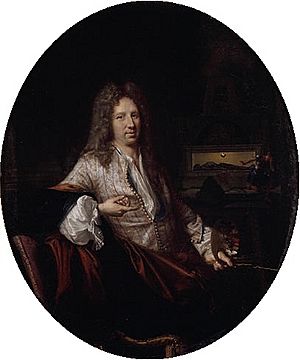René-Antoine Houasse facts for kids
Quick facts for kids
René-Antoine Houasse
|
|
|---|---|

Portrait of René-Antoine Houasse by François Jouvenet
|
|
| Born | 1645 |
| Died | 27 March 1710 (aged 64–65) |
| Occupation | Painter |
| Children | Michel Ange Houasse |
| Relatives | Nicolas Houasse (brother) |
René-Antoine Houasse (born around 1645, died 1710) was a talented French painter. He was known for his decorative paintings, which often made spaces look grand and beautiful.
René-Antoine learned his skills from a famous artist named Charles Le Brun. He worked with Le Brun at the Gobelins Manufactory, a famous workshop where beautiful tapestries and furniture were made. Together, they also helped decorate the magnificent Château de Versailles, a huge palace built for the French kings.
From 1699 to 1704, René-Antoine Houasse was the director of the French Academy in Rome. This was a very important role, as he was in charge of teaching young French artists who came to study in Italy.
Exploring Myths Through Art
René-Antoine Houasse painted many artworks that told stories from ancient Greek and Roman myths. He created a whole series of paintings about the goddess Athena, who the Romans called Minerva. She was the goddess of wisdom, warfare, and crafts.
Family Life
René-Antoine Houasse married Marie Le Blé on February 5, 1673. Marie was a cousin of his teacher, Charles Le Brun. They had three children together:
- Agnès-Suzanne Houasse (1674-1719): She married a sculptor named Nicolas Coustou.
- Michel-Ange Houasse (1680-1730): He became a painter just like his father. Michel-Ange was known for painting everyday scenes, which are called genre scenes.
- Marie-Charlotte Houasse: She married another sculptor, Pierre Le Gros the Younger, in Rome. After her husband passed away, Marie-Charlotte returned to Paris with her three children in 1723.
René-Antoine Houasse passed away in Paris on May 27, 1710.
Famous Artworks
René-Antoine Houasse created many important paintings and decorations. Here are some of his well-known works:
- Allegory of the Royal Magnificence (1678): An allegory is a painting that uses symbols to represent ideas. This painting likely showed the greatness of the French king.
- Ceiling paintings in the Salon de l’Abondance, Versailles: He helped decorate the ceilings of the rooms in the Palace of Versailles. The Salon de l'Abondance was a room celebrating wealth and plenty.
- Salon de Venus, Versailles: He also worked on the Salon of Venus, a room dedicated to the Roman goddess of love and beauty.
- Terror, Fear and Fright, Salon de Mars, Versailles: These paintings were part of the Salon of Mars, a room named after the Roman god of war.
- Morpheus & Iris (1688), Trianon: Morpheus was the god of dreams, and Iris was the goddess of the rainbow. These paintings were for the Trianon, a smaller palace on the grounds of Versailles.
- Cyane turned into a fountain (1688), Trianon: This painting shows the myth of Cyane, a nymph who was turned into a fountain.
- Minerva teaching the Rhodians sculpture (1688), Versailles: This artwork shows the goddess Minerva teaching the people of Rhodes how to sculpt.
See also
 In Spanish: René-Antoine Houasse para niños
In Spanish: René-Antoine Houasse para niños

